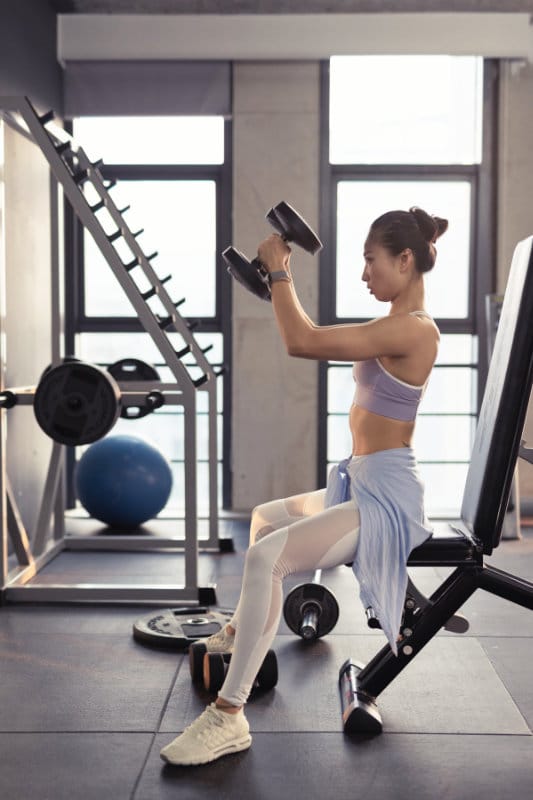HIIT has rapidly gained popularity with its proven efficacy in torching calories, improving cardiovascular health, and enhancing overall fitness. From fitness enthusiasts to athletes, the appeal of this training lies in its ability to deliver substantial benefits in shorter sessions, making it a practical choice for those with busy lifestyles.
Join us as we dive into HIIT’s principles, benefits, and real-life impact, paving the way for a fitter, healthier you.
In this article, we’ll dive into the basics and explore its benefits and drawbacks.
What is HIIT?
HIIT, or High-Intensity Interval Training: a workout involving alternating between energetic activity and periods of rest or low-intensity exercise.
Its goal is to challenge your body by pushing it to its capacity during bursts of intense activity, usually ranging from 20 seconds to 2 minutes. The rest periods help your body to recover before the next high-intensity interval.
This type of workout stands out for its emphasis on cardio workouts. The workouts frequently include activities such as running, cycling or rowing. They can incorporate bodyweight exercises like burpees, jumping jacks, and mountain climbers.
Taking breaks is just as important as the intervals. These rest periods allow the body to recuperate before diving into the round of high-intensity exercise.
Benefits of HIIT
Time Efficiency and Effectiveness
Research has indicated that High-intensity interval Training can potentially torch several calories within a duration compared to conventional cardiovascular exercises. [1] [2] A 30-minute workout involving high-intensity exercises can help you burn calories as a 60-minute jog on the treadmill.
The way HIIT is structured, with its alternating periods of exercise and brief breaks, enables people to achieve the possible outcomes quickly. You no longer need to spend hours at the gym; HIIT proves that quality can trump quantity regarding fitness.

Caloric Burn and Post-Exercise Calorie Consumption
The intense exercise intervals push your body into overdrive, triggering a substantial caloric burn during the workout. The afterburn effect implies that your body keeps burning calories after the session ends. This dual impact on calorie consumption makes HIIT a good tool for those aiming to shed pounds or maintain a healthy weight.
Cardiovascular Health
Another benefit is that it improves cardiovascular health. Engaging in High-Intensity Interval Training (HIIT) has demonstrated the ability to enhance an individual’s oxygen consumption (VO2 max), a measure of the highest quantity of oxygen the body can utilise during physical activity.
Adaptability to Various Fitness Levels
Whether you have been actively involved in sports for a time or are just starting to explore fitness, HIIT can be customised to fit your current abilities. The beauty lies in the scalability of intensity and duration. Novices can start with briefer, less intense intervals and then gradually advance, while advanced fitness enthusiasts can push their limits with longer and more vigorous intervals. This versatility ensures that virtually anyone can reap the benefits of HIIT, fostering inclusivity in the fitness world.
Drawbacks of HIIT
Although there are advantages, it is important to recognise that, similar to any exercise routine, it also has its limits. Understanding these drawbacks is key to practising HIIT safely and effectively.
1. Risk of Injury
This workout requires pushing your body to its limits; although this intensity level can deliver outcomes, it also increases the likelihood of sustaining injuries. Using improper form or technique during high-intensity intervals may lead to strains, sprains, or more severe injuries. This is particularly pertinent for beginners who might be new to the exercises incorporated in HIIT workouts. Proper guidance and a gradual progression into HIIT can mitigate this risk.
2. Health and Medical Considerations
People with health or medical conditions like heart disease should be careful before starting a HIIT program. Given the intensity of this workout, consult with a professional or doctor before starting. This will help ensure that the cardiovascular system can handle the added stress. Personalised advice can help tailor the exercise intensity to one’s health needs.
3. Mental and Physical Exhaustion
While it can be energising for some individuals, it is potentially draining for others mentally and physically. The demanding nature of high-intensity intervals may deter individuals who prefer a more moderate workout style. It’s crucial to recognise personal limits, listen to the body’s signals, and incorporate rest days into the routine to prevent burnout and reduce the risk of injury.

How to Start HIIT
First, consult a doctor or a healthcare professional before starting any exercise, workout plan or workout program. This step becomes even more crucial if you have underlying health conditions or concerns. Your doctor can provide personalised advice, ensuring that HIIT aligns with your health goals and doesn’t pose any unnecessary risks.
After getting approval from your doctor:
- Avoid jumping into high-intensity intervals immediately.
- Begin your HIIT journey at a speed that suits your current level of fitness.
- Make the intensity and duration of your workouts gradually increase over time.
This gradual change and progression help prevent injuries and allow your body to adapt and build endurance.
If you feel achy or notice indications of pushing yourself too hard, it’s important to not hesitate to give yourself a day of rest. A balanced approach, including rest days, is key to long-term success in HIIT.
Conclusion
HIIT is a dynamic and transformative experience that can elevate your fitness game and redefine your approach to exercise. The intensity may be challenging, but within that challenge lies the potential for growth, endurance, and a healthier, fitter you.
So, here’s to the HIIT journey—may it be invigorating, rewarding, and a source of lasting fitness gains. Your commitment to a fitter and healthier lifestyle is commendable, and as you continue to push boundaries and surpass limits, may you find fulfilment in the intensity and satisfaction of the progress.
References
[1] Falcone, P.H., Tai, C.-Y., Carson, L.R., Joy, J.M., Mosman, M.M., McCann, T.R., Crona, K.P., Kim, M.P. and Moon, J.R. (2015). Caloric Expenditure of Aerobic, Resistance, or Combined High-Intensity Interval Training Using a Hydraulic Resistance System in Healthy Men. Journal of Strength and Conditioning Research, 29(3), pp.779–785. doi:https://doi.org/10.1519/jsc.0000000000000661.
[2] Anderson, A. (2018). The Workout Debate: Experts Weigh in on Cardio VS. HIIT – PR News. [online] www.pennmedicine.org. Available at: https://www.pennmedicine.org/news/news-blog/2018/march/the-workout-debate-experts-weigh-in-on-cardio-vs-hiit.
Images Used
Photo by Li Sun: https://www.pexels.com/photo/photo-of-woman-sitting-and-raising-dumbbells-2475875/
Photo by Ivan Samkov: https://www.pexels.com/photo/person-holding-black-dumbbells-4164761/
Photo by Li Sun: https://www.pexels.com/photo/man-working-out-2294361/





0 Comments